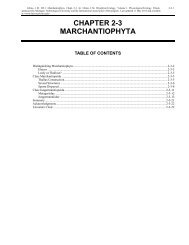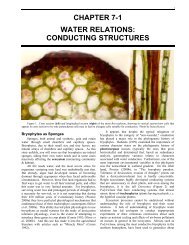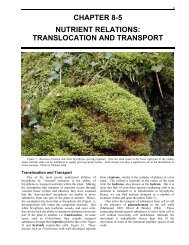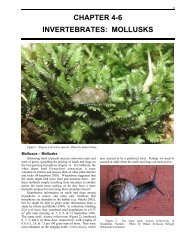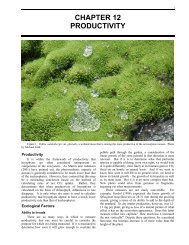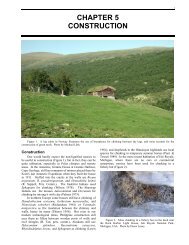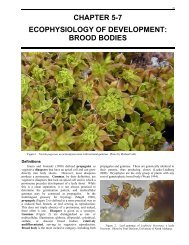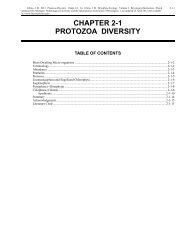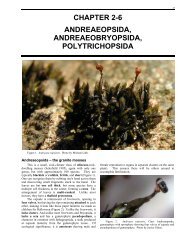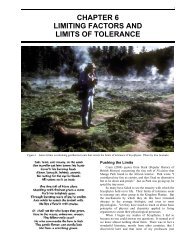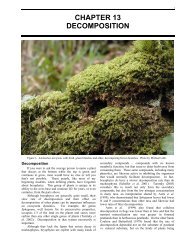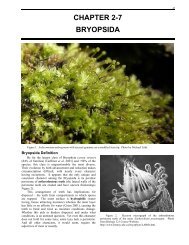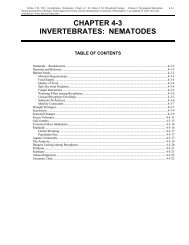Chapter 4-5 Invertebrates Rotifers - Bryophyte Ecology - Michigan ...
Chapter 4-5 Invertebrates Rotifers - Bryophyte Ecology - Michigan ...
Chapter 4-5 Invertebrates Rotifers - Bryophyte Ecology - Michigan ...
You also want an ePaper? Increase the reach of your titles
YUMPU automatically turns print PDFs into web optimized ePapers that Google loves.
Glime, J. M. 2013. <strong>Invertebrates</strong>: <strong>Rotifers</strong>. Chapt. 4-5. In: Glime, J. M. <strong>Bryophyte</strong> <strong>Ecology</strong>. Volume 2. Bryological Interaction. 4-5-1Ebook sponsored by <strong>Michigan</strong> Technological University and the International Association of Bryologists. Last updated 6 July 2013 andavailable at .CHAPTER 4-5INVERTEBRATES: ROTIFERSTABLE OF CONTENTSRotifera – <strong>Rotifers</strong>............................................................................................................................................... 4-5-2Reproduction....................................................................................................................................................... 4-5-2<strong>Bryophyte</strong>s as Habitat ......................................................................................................................................... 4-5-4Adaptations ......................................................................................................................................................... 4-5-6Physiological Adaptations to Drought ................................................................................................................ 4-5-7Food .................................................................................................................................................................. 4-5-10Role in the Food Web ....................................................................................................................................... 4-5-10Specific Habitats ............................................................................................................................................... 4-5-11Lobule Dwellers......................................................................................................................................... 4-5-11Roofs.......................................................................................................................................................... 4-5-14Antarctic..................................................................................................................................................... 4-5-15Peatland Habitats ....................................................................................................................................... 4-5-16Aquatic <strong>Bryophyte</strong>s.................................................................................................................................... 4-5-19Seasons.............................................................................................................................................................. 4-5-19Danger amidst the <strong>Bryophyte</strong>s .......................................................................................................................... 4-5-19Ozone Hole Dangers? ....................................................................................................................................... 4-5-21Extraction Techniques....................................................................................................................................... 4-5-21Summary ........................................................................................................................................................... 4-5-22Acknowledgments............................................................................................................................................. 4-5-22Literature Cited ................................................................................................................................................. 4-5-22
4-5-2 <strong>Chapter</strong> 4-5: <strong>Invertebrates</strong>: <strong>Rotifers</strong>CHAPTER 4-5INVERTEBRATES: ROTIFERSFigure 1. Two bdelloid rotifers like those that commonly inhabit bryophytes. Photo by Paul Davison.Rotifera – <strong>Rotifers</strong><strong>Rotifers</strong>, also known as wheel animals, are naturalpartners for organisms like bryophytes that oftenexperience extended periods of drought. Anthony vonLeeuwenhoek discovered in 1702 that rotifers couldtolerate months in a state of desiccation, hence marking theearliest studies on cryptobiosis, or life in a dormant statewithout water (Alpert 2000). In this dry state, they areeasily dispersed along with fragments of the mosses theyinhabit.Not much bigger than some protozoa (up to 2 mm),they form a phylum of their own, the Rotifera, with at least2000 species (Howey 1999). They are multicellular andeven possess a primitive brain, at least in females (Hingley1993).Reproduction<strong>Rotifers</strong> (depending on the taxon) have three types ofindividuals: mictic (mixing) females, amictic females (notreproducing sexually), and males. Bdelloid rotifers (classBdelloidea; Figure 2), known as moss rotifers, are themost common rotifers in mosses (Sayre & Brunson 1971;Ricci et al. 2003b; Gilbert & Mitchell 2006), andapparently all of these taxa are parthenogenetic, i.e., theyhave only females that reproduce asexually, giving rise tomore females (Hingley 1993). However, Danchin et al.(2011) analyzed the genome of one of these, Adineta vaga(Figure 3), and found four genotype modifications thatsuggested rare events of sexual reproduction may haveoccurred.The Monogononta are the second major class ofrotifers, and by far the largest (ca 1500 species) (Wikipedia2012a). Among these are members that have both sexualand asexual reproduction. The short-lived, uncommonmales, however, serve only for reproduction and thus aremuch smaller than females. Some males are so reducedthat they have little more than a bladder and a penis! An
<strong>Chapter</strong> 4-5: <strong>Invertebrates</strong>: <strong>Rotifers</strong> 4-5-3example is the mostly planktonic genus Brachionus(Wikipedia 2011; Figure 4). In this genus, increases inpopulation density can induce sexual reproduction. Itappears that at least in Brachionus calyciflorus only oneallele is needed to turn off sexual reproduction and force allreproduction to be parthenogenetic. Brachionus urceolarislives among bryophytes (Figure 5; Hingley 1993).Among the pliomates (order Pliomida in the classMonogononta), two types of reproduction occur. In onetype, females produce unfertilized eggs that develop intofemales, just as in the bdelloids (Hingley 1993). But in thesecond type, sexual females appear only whenenvironmental conditions are unfavorable, such as droughtor cold. These females produce a sexual egg that forms athick-walled resting "egg" when fertilized. That restingegg develops into a female. If the egg is not fertilized, itdevelops into a male.Figure 2. Examples of bdelloid rotifers and mastax. Photosby Diego Fontaneto and Giulio Melone.Figure 4. Brachionus sp. (Monogononta) with three eggs.Note the tiny red eyespot that is sensitive to light. Photo by Jean-Marie Cavanihac at Micscape.Figure 3. Adineta vaga, a moss dweller that is 0.2-0.3 mmwhen extended. Photo by Jean-Marie Cavanihac at Micscape.In Lecane inermis, a Sphagnum dweller, micticfemales have the longest lives of 11.1 ± 0.28 days,followed by amictic females with a lifespan of 8.9 ± 0.11days, and the shortest lifespan in males at 5.7 ± 0.07 days(Miller 1931). In males, death of 83% of the populationoccurs within the fourth to sixth days. Females lay one eggevery 8.6 hours, whereas the amictic female lays one every7.5 hours. Amictic females usually die within 24-36 hoursafter laying the last egg, but among the mictic females, 19% live six more days.Gilbert and Schroder (2004) suggested that thediapause (resting) eggs that develop into amictic femalesin species like Polyarthra vulgaris, occasionally a mossdweller, may be an adaptation for survival in anenvironment that is unstable. These amictic females have ahigher lipid content, reduced digestive tract, and produce asingle large egg within hours of hatching, whereas thenormal generation time is six days. The diapause eggs areproduced by sexual reproduction of a female and smallmale, thus producing a diploid egg. Like many algae andother plants, this behavior of sexual reproduction occurswhen the environment becomes unfavorable. The diapauseegg is able to remain viable without hatching for extendedperiods of time.Figure 5. Brachionus sp. Photo by Jean-Marie Cavanihac atMicscape.The lifespan of many rotifers is typically 30-40 days,not counting their time in dormant states (Ricci 2001). Andspecies of these animals can often be found in active ordormant states on both aquatic/wetland (Priddle & Dartnall1978; Bateman & Davis 1980; Ricci 1983; Ricci et al.1989; Linhart et al. 2002) and terrestrial mosses (Bartos1949; Ramazotti 1958; Overgaard-Nielsen 1967; Kukhta etal. 1990). Several species are even known from the harshenvironment of mosses growing on roofs (Hirschfelder etal. 1993).
4-5-4 <strong>Chapter</strong> 4-5: <strong>Invertebrates</strong>: <strong>Rotifers</strong><strong>Bryophyte</strong>s as HabitatMoss-dwelling rotifers have attracted the attention ofrotifer specialists for some time (Burger 1948). The familyHabrotrochidae seems to occur mostly on mosses but isalso benthic (Wallace & Snell 1991). There are twospecies in the genus Elosa that are common on Sphagnum.In her website on rotifers, Jean-Marie Cavanihacconsiders Rotaria rotatoria (formerly Rotifer vulgaris)(Figure 6) to be one of the most frequent rotifers onmosses, and as a free-living rotifer, it moves like acaterpillar.Figure 6. Rotaria rotatoria, a bdelloid rotifer from moss.Photo by Jean-Marie Cavanihac at Micscape.<strong>Bryophyte</strong> species composition explained most of thevariation in monogonont rotifers (Hájková et al. 2011).<strong>Bryophyte</strong>s formed four functional groups. Speciescomposition of monogonont rotifers differed significantly(P
<strong>Chapter</strong> 4-5: <strong>Invertebrates</strong>: <strong>Rotifers</strong> 4-5-5permanent residents contribute approximately 62% and95% in these locations, respectively. At Mlýnský náhon,the Bdelloid rotifers form 76% of the community aspermanent residents.Figure 10. Sphagnum palustre, a species with retort cells onthe stem that rotifers seem to avoid. Photo by Michael Lüth.An average of 700 rotifers can exist per gram on themosses Ceratodon purpureus (Figure 11), Polytrichumjuniperinum (Figure 12), Schistidium apocarpum (Figure13), and Sphagnum spp. (Figure 10) (Gerson 1982).Figure 12. Polytrichum juniperinum, a common rotiferhome. Photo by Michael Lüth.Figure 11. Ceratodon purpureus, a common moss on roofs,roadsides, and other open places. It typically has a largepopulation of rotifers. Photo by Geralyn Merkey.Aquatic rotifers can occupy a significant portion ofthe meiofauna of aquatic mosses such as Fontinalisantipyretica (Figure 14) (Vlčková et al. 2002). Out of 20taxa, Bdelloidea formed the dominant group with about76% of the total meiofauna numbers. Linhart et al. (2000)found that clumps of Fontinalis antipyretica was inhabitedby 151 times the densities of meiofaunal invertebratescompared to adjacent mineral substrate. During winter intwo streams in the Czech Republic, Linhart et al. found182,672-390,057 individuals per 100 mL of F.antipyretica. <strong>Rotifers</strong> (Bdelloidea) were the dominantorganisms, occupying up to 74% of the meiofauna. Therotifers seemed to be reduced by high amounts of organicmatter, whereas Chironomidae benefitted. Thesedifferences account for the dominance of rotifers(Bdelloidea) in Mlýnský náhon (76% of the community),whereas in Bystřice, the dominant group wasChironomidae (34%) (Vlčková et al. 2002).Although the aquatic moss Fontinalis antipyreticaoften lives in relatively rapid water, it can house hugenumbers of temporary and permanent meiofauna. Insamples taken in October and November, Vlčková et al.(2002) found 261,660 individuals per 100 mL of this mossin Bystřice and 498,948 in Mlýnský náhon. MoreFigure 13. Schistidium apocarpum, a common moss thatcan house 700 rotifers per gram. Photo by Michael Lüth.Figure 14. Fontinalis antipyretica, home for a dense faunaof rotifers. Photo by Michael Lüth.Aquatic mosses can contribute significantly tobiodiversity by providing a 3-d habitat. Linhart et al.(2002) and Vlčková et al. (2002) found that rock rip-rapovergrown by aquatic mosses (Fontinalis antipyretica) in aside channel of the Morava River, Czech Republic,
4-5-6 <strong>Chapter</strong> 4-5: <strong>Invertebrates</strong>: <strong>Rotifers</strong>contributed both habitat and food source for the meiofauna.Both the habitat and the food source were realized throughthe fine particulate matter trapped by the mosses. In thishabitat, Bdelloid rotifers dominated as 76% of theorganisms among 18 meiofaunal taxonomic groups.In moss cushions of Antarctic nunataks, Sohlenius andBoström (2006) found that 82% of their 91 samples hadrotifers, the highest, above the nematodes (64%) andtardigrades (32%). Petz (1997) found that 95% of thesamples from Wilkes Land, East Antarctica, had rotifers,with the highest numbers in mosses (1,311/g), although itwas tardigrades that dominated. Water and organic matterseemed to be the most important controlling factors forthese invertebrate numbers.Before we explore this group of organisms, we need toconsider potential sampling bias and the effects it may haveon the numbers of rotifers in various studies. Because oftheir tendency to attach, rotifers require different samplingtechniques from tardigrades and worms. They do notextract well with the Baermann funnel used so commonlyfor other invertebrates (Merrifield & Ingham 1998).Merrifield and Ingham tested the efficiency of this funneltechnique on the moss Eurhynchium oreganum on theOregon Coast Range, USA, by squeezing and agitating themoss after the funnel extraction and suggested that theirsedentary habit might cause them to be undersampled.AdaptationsLittle has been discussed about adaptations of rotifersto the bryophyte habitat. <strong>Rotifers</strong> among bryophytes canfeed on detrital matter collected by the bryophytes.Kellicottia longispina (Figure 15) is a common planktonspecies that may be well adapted for bryophyte living. Ithas very long spines on its case (lorica) that enable it toattach to the bryophytes (Madaliński 1961).Aquatic bryophytes may provide a refuge duringparticularly heavy stream flow. The number of species inTatra streams increased during spring runoff from 18 inwinter to 24 during runoff (Madaliński 1961). Other factorsthat contribute to substrate choice include temperature,oxygen content, trophic levels, chemistry, food availability,and predators (Pejler & Bērziņš 1989).Two rotifers have found a different way to surviveamong bryophytes. In addition to living in Sphagnumretort cells, Habrotrocha roeperi and Habrotrocha reclusalive inside the outer cells of Sphagnum branches (May1989). May states that these could be considered asparasites. I find this a bit of a puzzle. Variousinvertebrates are known to live in stem cells that havepores, providing an entryway. But how do the rotifers getinto the branch cells?Living in tune with their mossy environment,limnoterrestrial rotifers exhibit a seasonal dynamic thatdepends on water availability and air quality (Kukhta et al.1990; Steiner 1994a, b, 1995a, b). Not only is waterimportant for hydration, but it is necessary for locomotion.The bdelloid rotifers (Figure 2) have a contractile body thatpermits them to creep around on the moss (Sayre &Brunson 1971). And the cilia that form the corona createcurrents as they beat (Figure 16), directing food particlesinto the mouth while thrusting the rotifer forward (Hingley1993). Thus, the corona also contributes to movement.Figure 15. Kellicottia longispina showing its long spinesthat permit it to attach to bryophytes. Photo from Jersabek et al.2003.Pejler & Bērziņš (1989) have somewhat different ideasabout long spines. They claim these are generally found inclear water as a protection against visual predators. This isconsistent with defense against predation shown byBarnhisel (1991) for Bythotrephes, a cladoceran. Rather,Pejler and Bērziņš suggest that adaptations involve thesuitability of the foot, egg-carrying protrusions, and otherlorical structures. Certainly diet plays a role, with somebryophytes being suitable food for detrital feeders.If you are tiny and soft-bodied, you certainly needsome sort of protection or a place to hide. Otherwise, youwill be somebody's dinner. Wilts et al. (2010) discoveredone of the smallest rotifers known, Bryceella perpusilla, anew species, on terrestrial mosses in Germany.Figure 16. Wheels of cilia (corona) on Floscularia sp.(Monogononta). Photo by Martin Mach.Some rotifers are too large to live among bryophytes,in part because the bryophytes cannot house enoughdetritus and bacteria to meet the food needs of the rotifer(Cavanihac 2004; Figure 17).Epp and Lewis (1984) demonstrated that speed ofmotion was related to size in rotifers. Using Brachionusand Asplanchna, they demonstrated that Brachionus haslittle size variation during its development, whereasAsplanchna increases significantly in size as it develops.Nevertheless, both genera decrease their speed ofmovement significantly as their size increases. Brachionususes 62% of its energy for ciliary movement. This is a veryinefficient activity, so one might consider one bryophyteadaptation to be movement instead by crawling. To
<strong>Chapter</strong> 4-5: <strong>Invertebrates</strong>: <strong>Rotifers</strong> 4-5-7observe the in motion, let the wet moss sit for 30 minutesbefore observation to provide the rotifers sufficient time tobecome active.Figure 17. Cupelopagis vorax, a rotifer that finds a mossleaf too small for its feeding needs. Photo by Jean-MarieCavanihac at Micscape.Although not restricted to these habitats, rotifers arecommon on mosses, in alpine Sphagnum bogs, and inwetlands. <strong>Bryophyte</strong>s may be particularly useful to streamand other aquatic rotifers as a substrate. Pejler and Bērziņš(1989) contend that rather than any chemical attraction fora substrate, some substrates might be avoided, perhaps dueto lack of periphyton. The genus Lecane is a widespreadgenus that has little preference for any particular substrate(Pejler & Bērziņš 1994). In fact, it furthermore seems tohave good dispersal, as indicated by its rapid ease ofcolonization on an artificial substrate of cotton. Fontanetoand Ricci (2000) consider that rotifers are probably bestdispersed in their dormant state.Physiological Adaptations to DroughtAnhydrobiosis, a dormant state caused by loss ofwater, permits some rotifers to live with the same waterstresses to which bryophytes are subjected. <strong>Rotifers</strong> enterthis state in stages (Ricci & Melone 1984). First theycontract into the compact shape known as a tun (Marotta etal. 2010). During this contraction, the cephalic and caudalextremities are withdrawn into the trunk. Presumably, thisreduces the rate of water loss and minimizes water loss inthe dormant state. The tissues and cells become packed,preserving their integrity (Ricci 2001). This preparationrequires several hours, and a shorter period can reduce therecovery success (Caprioli & Ricci 2001). As innematodes and tardigrades, trehalose is produced andstored. This molecule helps to stabilize cellular structuresand preserve molecular integrity. Despite all thispreparation, these dormant beings are not as well protectedas we once thought. At least one species has lost survivalcapability at high temperatures and both low and highhumidity. Nevertheless, Macrotrachela quadricornifera(Figure 18) survived 59 years on a moss on a herbariumsheet, becoming active when it was rewet (Rahm 1923).However, even in this species the success of recoverydecreases with time (Caprioli & Ricci 2001).Certainly one of the most important adaptations ofbryophyte dwellers is this ability to withstand drying.Bdelloid rotifers in particular are common amongbryophytes and humus-containing soil (Sládeček 1983).Many of these are able to desiccate for long periods of timeand become active again. Pennak (1953) reports onebdelloid rotifer that revived after 27 years of desiccation.When fifteen bdelloid species (6 genera) were collectedfrom water and terrestrial moss environments, the highestrecovery rates following anhydrobiosis for seven days werefor the adults from mosses (Ricci 1998). Activity generallyresumed in about one hour after rehydration. Riccisuggests that all bdelloid rotifers originally had the abilityto enter anhydrobiosis, but that some species havesubsequently lost it. Aquatic species had only 20-50%recovery among young, pre-reproductive individuals,whereas moss-dwelling species had 50-100% recoveryamong these juveniles. This improved in adults of bothgroups. Could it be that this group evolved originally in amoss habitat? On the other hand, Otostephanosmacrantennus, a moss and soil dweller, did not survivedesiccation at any life stage, except for one individual olderadult. Furthermore, its eggs collapsed and were unable tosurvive desiccation, whereas the overall viability amongthese fifteen species was 40-60%.Figure 18. Macrotrachela quadricornifera. Photo by DiegoFontaneto and Giulio Melone.In a study of nine species of bdelloid rotifers, Ricci(1983) found that those moss-dwelling terrestrial rotifersliving in unpredictable environments had less likelihood ofreproducing than aquatic species with a more predictableenvironment. Thus, it is not surprising that theyreproduced less, but lived longer. Moss-dwelling speciestend to reproduce throughout their mature lives and neversenesce, whereas the aquatic species have a greaterreproductive output and are more likely to die afterreproduction, having a senescent period at the end of theirlives. The strategy of the aquatic species would not servethe moss-dwelling taxa well due to the unpredictable natureof the habitat. The moss-dwellers, on the other hand, canenter a state of anhydrobiosis when the conditions becomeunfavorable. During this state they can tolerate extremes of
4-5-8 <strong>Chapter</strong> 4-5: <strong>Invertebrates</strong>: <strong>Rotifers</strong>temperature and desiccation and do not need food.Frequent reproduction could be detrimental to theseanimals if they do not have sufficient resources to sustainthem during the anhydrobiotic state. Success is furthersupported by a delay in maturity that reduces reproductivecost. On the other hand, in the water, large adults may beeasy prey, favoring a shorter time to maturity.The temperature relationships of the moss-dwellingrotifers are interesting. Compared to the non-mosspopulations, those of Macrotrachela quadricorniferaliving among mosses exhibit an irregular response toincreasing temperature in the range of 16-24°C (Ricci1991). Furthermore, the aquatic (non-moss) strainsinvested maximum resources in reproduction (r strategists),consequently reducing their survival, whereas the mossdwellingstrains were long-lived and invested fewerresources in their reproduction (K strategists). Ricci pointsout that the moss habitat experiences a much greatertemperature fluctuation in a shorter period of time thanwould occur in the aquatic non-moss habitats. Riccisuggests that the terrestrial moss habitat has much moreimportant limiting factors – availability of food andmoisture, whereas a wide temperature range with suddenchanges must be tolerated.The moss-dwelling rotifer strains differ slightly insize, with moss-dwellers being smaller than the aquaticstrains. Among the Macrotrachela quadricornifera, eggsand juveniles are less able to recover from desiccation thanare mature animals. This species is a good bet-hedger,encompassing multiple strategies for survival in a varietyof habitats. The moss habitat undoubtedly offers theadvantage of slow drying, which increases survivorshipupon rewetting (Ricci et al. 2003a).Macrotrachela quadricornifera, a bdelloid rotifer, isa filter feeder whose food preference and survivorship alsodiffered among the habitat strains (Ricci 1991). Mossdwellers were unable to survive on yeast (Saccharomycescerevisiae) alone, whereas the two aquatic strains survivedand grew. One of the moss-dwelling strains was unable toeat Chlorella pyrenoidosa. The other moss strain did beston Escherichia coli, which resulted in poor growth of allthe other strains. It appears that the habitat may influencethe types of enzymes available for digestion of food. Wecannot, however, say if this is an environmental responseduring development or a genetic one that has persistedthrough a number of moss-dwelling generations.On the other hand, the moss-dwelling Macrotrachelaquadricornifera suffers a much shorter desiccation survivalperiod (Ricci et al. 1987). In experiments, five-day-oldstressed rotifers had significantly decreased fertility,whereas 14-day-old stressed individuals had decreased lifespans. Age also affected ability to survive drying. Thehighest recovery rate occurred for 8-day-old rotifersstressed for 4 days, whereas no rotifers aged 5 dayssurvived 30 days of drying. Macrotrachelaquadricornifera shrinks considerably in size duringdehydration, with the anhydrobiotic animal having onlyabout 60% of the volume of the hydrated form (Ricci et al.2008; see also Marotta et al. 2010). The internalorganization changes drastically, with body cavitiesbecoming indistinguishable. Even more extreme is its lossof more than 95% of its weight when anhydrobiotic, mostlyas water. This water loss is inconsistent with a 60%volume loss and Ricci and coworkers suggest that it mayindicate presence of space-filling molecular species in thedehydrated animal.One reason for the abundance of bdelloid rotifers onbryophytes is that they share with the bryophytes thisability to enter the state of cryptobiosis (anhydrobiosis)(Wallace & Snell 1991; Fontaneto & Ricci 2004). Guidetti& Jönsson (2002) examined rotifers that had been kept dryfor 9-138 years. The adult stage may have a limitedcryptobiotic lifespan in the presence of oxygen, but therotifer Mniobia (Figure 19) survived live as eggs for nineyears on bryophytes, suggesting that the egg stage (Figure20) might have greater longevity than the cryptobiotic adultstage. This appears to be the longest record for rotifersurvival in anhydrobiosis other than the 59 years for anadult reported by Rahm (1923) from a herbarium moss.Figure 19. Mniobia sp. with egg. Photo by Walter Dioni.Figure 20. Egg stage of a rotifer on algae. Photo by MichelVerolet.Ability to contract and fold seems important to thesurvival of Macrotrachela quadricornifera (Ricci et al.2004). Upon drying, the rotifer contracts, drawing its footand head into the body trunk (Ricci & Melone 1984).Starved rotifers of this species survive better than those fedon concentrated food, with food remaining in the gut whenthe latter form the tun (Figure 21) (Ricci et al. 2004). It ispossible that the reason for the reduced survivorship is thatthe food interferes with the necessary folding andcontraction.These data for Macrotrachela quadricornifera raisethe question of how these animals survive on bryophytes.For these experiments, the mosses were collected from aspring-fed pond in Italy (Ricci et al. 1987). Hence, it islikely that the humidity remained higher than that of the
laboratory. Furthermore, the mosses themselves providecapillary spaces that can lock in water for a longer periodof time than that of the surroundings. Unlike the rotifersthat depend on eggs for reproduction, bdelloid rotifers inthis study had a much lower hatching rate (19%) comparedto 40-100% (Pourriot & Snell 1983) reported for thosespecies that depend on resting eggs to colonize newenvironments. Macrotrachela quadricornifera is aparthenogenetic rotifer, requiring no partner to reproduce.Therefore, its life on a moss leaf is not dependent onfinding a partner in what can be an isolated habitat. Theability of the moss leaf to disperse in the wind provides ameans for the rotifer likewise to disperse.<strong>Chapter</strong> 4-5: <strong>Invertebrates</strong>: <strong>Rotifers</strong> 4-5-9Figure 23. Colonial species of Conochilus, a genus that usesmucus as protection. Photo by Wim van Egmond.Figure 21. Tun of a rotifer. Photo by Michel Verolet.When Caprioli and Ricci (2001) experimented withMacrotrachela quadricornifera, Philodina roseola, andAdineta oculata, they found that these bdelloids are able tosomewhat regulate the net water balance during the onsetand termination of anhydrobiosis.Habrotrocha sp. secretes a mucous that makes itappear much larger (Figure 22) (Michel Verolet). Wallaceand Snell (1991) considered mucous to be an adaptationagainst predation in the rotifers Conochilus (Figure 23)and Lacinularia, but it would seem it would likewiseprotect rotifers such as Habrotrocha against desiccation ina mossy habitat where some members of the genus areknown to live. Others, such as Keratella, are protectedfrom both desiccation and predation by armor (Figure 24-Figure 25), with spines that may help against predation.Figure 24. Keratella, showing armor and spines. Photo byWim van Egmond.Figure 22. Habrotrocha sp. surrounded with mucous it hassecreted, presumably providing it with protection againstdesiccation. Photo by Michel Verolet.Figure 25. Armor of the rotifer Keratella sp. Photo by PaulDavison.
4-5-10 <strong>Chapter</strong> 4-5: <strong>Invertebrates</strong>: <strong>Rotifers</strong>Food<strong>Rotifers</strong> obtain their food by rotating cilia in thecorona that directs the food into the mouth. This enablesthem to eat small particles of organic matter, bacteria,algae, protozoa, and even other rotifers (Wikipedia 2012b).[These same cilia can be used for swimming (Fontaneto &Ricci 2004)]. The food is directed to the mouth and themastax (Figure 2), the latter consisting of the trophus andits musculature. This menu usually consists of food itemsthat are up to 10 µm in size (Wikipedia 2012b). Thisability to filter such small particles from their environmentmakes them useful in maintaining clean water in aquaria.Clément et al. (1980) described the muscle structure andmethod of controlling the cilia to obtain food for Philodinaroseola and Brachionus calyciflorus and their ability toreject some foods.Figure 27. Asplanchna sp. overfed on Keratella sp. Thislarge rotifer died after eating a large quantity of the smallerKeratella (van Egmond 2003). Photo by Wim van Egmond.Figure 26. Philodina rosea showing cilia that direct foodinto the mouth. Photo by Wim van Egmond.Role in the Food WebTiny animals usually have bigger animals that eatthem. The rotifers fall prey to copepods, fish, and Bryozoa,but small rotifers are also eaten by bigger rotifers (Wallaceet al. 2006). For example, members of the rotifer genusLecane are eaten by the rotifer Dicranophorus robustus(Jersabek et al. 2003), both known from bryophytes. Onthe other hand, when the Asplanchna ate too muchKertella, the Asplanchna died, possibly due to the spindein the Keratella (Figure 27).Most of the rotifer inhabitants of Sphagnum feed onsmall particles of food directed to them by their wheel cilia(Figure 28) (Hingley 1993). They mash their food with amodified pharynx called a mastax (Figure 29-Figure 30),thus modifying these in the ecosystem.But little rotifers have bigger enemies and may needrefuge, even among bryophytes. Some rotifers, especiallysessile rotifers, are easy prey for larger invertebrates. Forexample, Antarctic tardigrades appear to be importantpredators on rotifers (Sohlenius & Boström 2006). Somerotifers make tubes. Ptygura velata solves the problem ofbecoming dinner by making a tube from its own fecalpellets (Figure 31-Figure 32), where it withdraws fromdanger (Edmondson 1940).Figure 28. The two "wheels" on this moss-dwelling rotiferare in full motion. Photo by Andi Cairns.Figure 29. Colurella adriatica, showing location of themastax and other prominent features. This one is sitting on thegreen alga Spirogyra sp., but it sometimes occurs among mosses.Photo by Michel Verolet.<strong>Rotifers</strong> participate in a food web within the mosshabitat. Rotifer biomass on Sphagnum fallax decreased inresponse to experimentally added lead (Nguyen-Viet et al.
2007). The mechanism, however, appeared to be indirectdue to the loss of microbial biomass and not due to thedirect effects of lead on the rotifers. The biomass ofbacteria, microalgae, testate amoebae, and ciliatesdecreased significantly and "dramatically." The linkageappears to be that bacteria provided food for the ciliate andtestate protozoa, and these in turn provided food for therotifers. <strong>Rotifers</strong> do have preferences, and thesepreferences affect the species composition of algae in theirecosystems (Wikipedia 2012b). They also affect thespecies composition through competition for food withCladocera and copepods.<strong>Chapter</strong> 4-5: <strong>Invertebrates</strong>: <strong>Rotifers</strong> 4-5-11Figure 32. Close view of Ptygura sp. showing fecal pelletsin the case. Photo by Wim van Egmond.Figure 30. Mastax, showing the two trophi of a rotifer formthe liverwort Frullania eboracensis. This structure is used forcrushing food items. Photo by Mark Pokorski.Specific HabitatsWe would probably make some very interestingdiscoveries if bryologists and rotifer biologists would joinforces. But rotifer folks rarely name the bryophytes wheretheir rotifers dwell, and most bryologists can't name therotifers they find. Some rotifers may have very specifichabitats, particularly among bryophytes that offer unusualconditions.Lobule DwellersFigure 31. Ptygura sp. with its case made of its own fecalpellets, attached to a Sphagnum leaf. Photo by Wim vanEgmond.In North America, Puterbaugh et al. (2004) found thatrotifers were common in the lobules of the leafy liverwortFrullania eboracensis (Figure 33-Figure 38). The youngerouter portions of the plants had more rotifers in the lobulesthan did the interior lobules. Sterile plants had a mean ratio± 1 standard error of 0.83±0.15 rotifers per lobule. Maleand female plants had a mean ratio of 0.38±0.04 rotifersper lobule. Sterile plants likewise tend to be younger.Since we would expect older lobules to have more rotifersdue their greater time available for colonization, thesefindings suggest that older portions may have something,perhaps a chemical exudate, that discourages thecolonization by rotifers.<strong>Rotifers</strong> seem to be common in lobules. Blanka Shawhas provided me with pictures of Microlejeunea ulicina(Figure 39) from Whitewater Falls in Transylvania County,North Carolina, USA, with rotifer inhabitants, again inlobules. These initially motionless animals began movingtheir "wheels" when the warmth of the microscope lightactivated them. Hess et al. (2005) found rotifers in lobulesof Colura sp. (Figure 40-Figure 42) and Pleuroziapurpurea (Figure 43-Figure 47). These liverworts have atrap lid on the lobules, and it appears that the inhabitantsmight not be able to escape, dying in the lobule (trap) and
4-5-12 <strong>Chapter</strong> 4-5: <strong>Invertebrates</strong>: <strong>Rotifers</strong>contributing organic matter that could break down andprovide nutrients. However, there does not seem to be anyevidence that Microlejeunea or Frullania have thistrapping action.Figure 36. Bdelloid rotifer on lobule of Frullaniaeboracensis. Photo by Mark Pokorski.Figure 33. Frullania eboracensis with a rotifer in itslobule. Photo by Robert Klips.Figure 37. Lobules of Frullania eboracensis with dormantrotifers. These dormant stages could be resting eggs or cysts.Photo by Mark Pokorski.Figure 34. Bdelloid rotifers in lobules of Frullaniaeboracensis. Photos by Mark Pokorski.Figure 38. A Frullania lobule houses this rotifer. Photo byAndi Cairns.Figure 35. Frullania eboracensis with bdelloid rotifers asinhabitants. Photos by Mark Pokorski.Frullania seems to house rotifers of many species andlocations. Tom Thekathyil (Bryonet 19 November 2011)reports that he has found them living in lobules ofFrullania rostrata in New Zealand. Andi Cairns has foundthem in Australia (Figure 38).Figure 39. Microlejeunea ulicina with a rotifer emergentfrom a lobule. Scale is 50 µm. Photo by Blanka Shaw.
<strong>Chapter</strong> 4-5: <strong>Invertebrates</strong>: <strong>Rotifers</strong> 4-5-13Figure 40. Colura calyptrifolia, a leafy liverwort withlobules where rotifers can live. Photo by Michael Lüth.Figure 44. Branch of Pleurozia purpurea. Photo bySebastian Hess.Figure 45. Lobule of Pleurozia purpurea showing the trapand lid. Redrawn from Hess et al. 2005.Figure 41. Colura leaf with lobule where rotifers often live.Photo by Jan-Peter Frahm.Figure 42. SEM of Colura leaf lobule where rotifers oftenlive. Photo by Jan-Peter Frahm.Figure 46. Leaf of Pleurozia purpurea showing lobule andlid. Photo by Sebastian Hess.Figure 43. Pleurozia purpurea, a leafy liverwort withlobules that house, and possibly trap, rotifers and other fauna.Photo by Janice Glime.Figure 47. Lobule of Pleurozia purpurea showing lid.Photo by Sebastian Hess.
4-5-14 <strong>Chapter</strong> 4-5: <strong>Invertebrates</strong>: <strong>Rotifers</strong>Claudine Ah-Peng reports that she was surprised tofind invertebrates in the lobules of some species ofLejeuneaceae, notably in the lobules of Acrolejeuneaemergens (Figure 48-Figure 49). These occurred on plantsat the Piton de la Fournaise volcano (Réunion in the IndianOcean) collected on a 1986 lava flow.of these interesting invertebrates (Javier Martínez Abaigar,pers. comm. 2008), as do mosses (Figure 51-Figure 52).Figure 51. Bdelloid rotifer taken from bryophytes. Photoby Dan Spitale.Figure 48. Acrolejeunea emergens with several orangeinvertebrates in the lobules. These appear to be resting stages ofrotifers. Photo by Claudine Ah-Peng.Figure 52. Moss-dwelling rotifer from the moss Sanioniauncinata on the Barton Peninsula of King George Island,Antarctica. Photo by Takeshi Ueno.Figure 49. Acrolejeunea emergens with an emerginginvertebrate, probably a rotifer, in the lobules. Photo by ClaudineAh-Peng.Figure 50. This rotifer, with its "wheels" hidden and its toesshowing, is feeding on detrital material associated with theliverwort Jungermannia cordifolia. Photo by Javier MartínezAbaigar.Lobules are not necessary for rotifer habitation of theleafy liverworts. Jungermannia cordifolia (Figure 50),with only a flat leaf surface to offer, likewise has its faunaDes Callaghan (Bryonet 10 November 2012) kindlyprovided us with a YouTube video of rotifers feeding fromthe lobules of Lejeunea patens in Wales. I knew that theciliated "wheels" directed food into the mouth, but I neverrealized the speed or the distance of that effect. Theparticles started outside the field of view and travelledfarther than the extended length of the rotifer. Someparticles came from near the foot and others shot in like ameteor from the height of the cilia or a little above, butfrom some distance.RoofsColonization of mosses on roofs permittedHirschfelder et al. (1993) to compare species of rotifers onan upright acrocarpous moss (Ceratodon purpureus;Figure 11) and a mat-forming pleurocarpous moss(Brachythecium glareosum; Figure 53). They collectedmosses every two weeks from roofs aged 3-92 years, driedthem at 20ºC, and cut them into small pieces. The pieceswere re-wet in deionized water and examined for theawakening rotifers. The mat-forming moss hadsignificantly more species and greater numbers of rotifersthan did the upright moss, but species on C. purpureusdiffered little from those that could be found on B.glareosum. They found that rotifer colonization of themosses continued for decades and that the colonization bythe mosses was rapid. Nevertheless, the numbers ofspecies increased with time (Figure 54).
<strong>Chapter</strong> 4-5: <strong>Invertebrates</strong>: <strong>Rotifers</strong> 4-5-15Figure 53. Brachythecium glareosum, a rotifer habitat onroofs. Photo by Des Callahan.Figure 55. Cephalodella auriculata (Notommatidae), acold-water (Segers 2001) benthic and epiphytic moss-dwellingrotifer. Photo by Michel Verolet.Figure 56. Cephalodella gibba, an aquatic rotifer (Segers2001), typically occurring in the sediments (Hingley 1993;Schmid-Araya 1995), is found among the Antarctic mosses (DeSmet 2001). Photo by Michel Verolet.Figure 54. Succession with time of increasing number ofrotifer species on roofs. Redrawn from Hirschfelder et al. 1993.AntarcticThe Antarctic mosses sport an active community ofinvertebrates that move among the stems and branches.Priddle and Dartnall (1978) found six attached rotiferspecies that preferred the middle stem zones where thehighest growths of epiphytic algae and other epiphyticorganisms occurred. Of these, four species chose leafaxils, whereas the other two settled on the bare underside ofthe leaf. Priddle and Dartnall showed experimentally thatwind caused mixing in summer, resulting in the transport oflarval rotifers from shallow portions of the lake.Some of the known Antarctic bryophyte dwellers areCephalodella auriculata (Figure 55), a cold-water species(Segers 2001), C. gibba (De Smet 2001; Figure 56), a coldwaterspecies (Segers 2001) known from habitats with pH
4-5-16 <strong>Chapter</strong> 4-5: <strong>Invertebrates</strong>: <strong>Rotifers</strong>Figure 59. Testudinella patina; some members of this genusare Antarctic moss dwellers. Photo by Yuuji Tsukii.Peatland HabitatsSphagnum seems to be as important for rotifers as it isfor micro-organisms. Unique communities characterize thevarious stages in the peatland ecosystem (Francez &Devaux 1985). Some rare species can be common amongSphagnum. That is the case for the rare Tetrasiphonhydrocora in Lac des Femmes, Quebec, Canada (Norgrady(1980). One reason for the occurrence of rare speciesamong Sphagnum may be its ability to serve as a safesite/refugium against predators (Kuczyńska-Kippen 2008).In a poor fen in Newfoundland, Canada, Bateman andDavis (2007) found 25 bdelloid and 39 monogonontrotifers. Among these, 27 were new records for Canadaand 13 new for North America. They found an average of354 rotifers per cm 2 and 17 species per formation. Thesewere seasonal, with the monogononts almost vanishing inwinter. The bdelloids decreased, but not so dramatically.The hummocks and hollows present very differentmoisture and temperature regimes, and this is representedby differences in rotifer species (Bateman & Davis 2007).The summits of the hummocks were predominatelybdelloid rotifers, although these never became desiccated,with the number of monogononts increasing in bothspecies richness and numbers of individuals on the slopes,reaching their greatest numbers in the hollows.As the peatland water content decreases, the faunabecome less like that of open water. Among peat mosses,the species with the highest percentage of characteristicrotifer species is the oligotrophic Sphagnum angustifolium(Figure 60) of low moors (Francez & Devaux 1985). Pejlerand Bērziņš (1993) found most bdelloids need lots ofoxygen, but some survive in soft bottom sediments. Thediversity of habitats in bogs results in several speciespreferring the bog ecosystem.Many rotifers are missed during casual observancebecause their size is less than 200 µm (Gilbert & Mitchell2006). Some are missed because they hide inside hyalinecells of Sphagnum leaves and stems, entering through thepores (Hingley 1999), or in outer branch cells (May 1989).Some rare species can be found in peatlands, rare perhapsbecause that habitat has not been sampled as much forrotifers. For example, Tetrasiphon hydrocora was notuncommon in association with Sphagnum in Lac desFemmes, Quebec, Canada, yet seemed to be generally rare(Norgrady 1980). It likewise was one of the rotifersreported in the peatland study by Hingley (1993) .Figure 60. Sphagnum angustifolium, the oligotrophicspecies in low moors with the highest percentage of rotiferspecies. Photo by Michael Lüth.As noted, the Bdelloidea are the dominant group, inpeatlands mostly represented by the genera Philodina(Figure 61-Figure 62) and Habrotrocha (Figure 63)(Gilbert & Mitchell 2006). Among the Monogononta,peatlands are occupied mostly by Colurella (Figure 29),Euchlanis (Figure 66-Figure 65), Lecane (Figure 68-Figure 67), and Trichocerca (Figure 7) (Gilbert & Mitchell2006). Francez (1981), who identified 142 species inpeatlands, found that in France both abundance and averagesize were greater in fens than in bogs. Many kinds ofrotifers are unable to live among peat mosses because ofthe high degree of acidity (Hingley 1993).Figure 61. Philodina on the alga Spirogyra. Photo by YuujiTsukii.Figure 62. Extended Philodina. Photo by Jean-MarieCavanihac at Micscape.
<strong>Chapter</strong> 4-5: <strong>Invertebrates</strong>: <strong>Rotifers</strong> 4-5-17Figure 63. Habrotrocha rosa (Bdelloidea). Photo by Rkitkofrom Wikipedia Commons.Figure 67. Lecane sp. Photo by Jean-Marie Cavanihac atMicscape.Figure 64. Euchlanis, a genus having peatland rotifers.Photo by Yuuji Tsukii.Figure 65. Euchlanis. Photo by Jean-Marie Cavanihac atMicscape.Figure 66. Euchlanis. Photo by Jean-Marie Cavanihac atMicscape.Figure 68. Lecane (Monogononta), a common peatlandrotifer. Photo by Yuuji Tsukii.The genus Lecane enjoys widespread distribution,including the Antarctic. Nevertheless, there are species inthis genus restricted to Sphagnum bogs (Pejler & Bērziņš1994).The acidity of the water may play a role in distribution,but it is difficult to determine if it is a direct or indirecteffect. Bērziņš and Pejler (1987) found that oligotrophic(low nutrient) species occur at a pH optimum at or below7.0, whereas eutrophic species are generally at or abovethis level. The rotifers may be there because of a suitablepH and absent elsewhere because the pH is too high or toolow, or they may be there because they are limited to aparticular substrate such as Sphagnum, which is itself
4-5-18 <strong>Chapter</strong> 4-5: <strong>Invertebrates</strong>: <strong>Rotifers</strong>limited to that same pH range (Edmondson 1940).Edmondson considers the rotifers Lecane satyrus,Notommata falcinella, Lindia pallida, among others, to belimited to Sphagnum. Jersabek et al. (2003) also reportedNotommata falcinella from submerged Sphagnum inMaryland, USA. In these cases, it appears to be thesubstrate that is important, as these species are not found onother substrates at the same pH. In the Wisconsin study ofEdmondson (1940), Ptygura mucicola socialis was foundamid a colony of the Cyanobacterium Gloeotrichia sp. atthe low pH of 3.5 in a Sphagnum peatland. It is interestingthat these rotifers are often associated with algae on themosses, presumably using them as a food source, althoughit might be other organisms associated with them thatprovide the food.Flat, broad surfaces do not seem to be suitable for mostsessile rotifers. Edmondson (1940) suggested this mayrelate to their method of feeding. But it could also relate tocapillary water. Sphagnum leaf morphology seems to playa role in the location of the rotifers. The rotifer Collothecagracilipes lived on the concave side of a submerged mossleaf along with the green algae Bulbochaete andOedogonium (Edmondson 1940). And Collothecacucullata occurred on the concave side of a Sphagnum leafin a different peatland at pH 5.6. Ptygura velata likewise isfound on the concave side of the leaf, suggesting theimportance of water held there by capillarity in theinterstitial spaces. On Sphagnum perichaetiale (syn.Sphagnum erythrocalyx; Figure 69-Figure 70), the rolledtip of the leaf provides a similar protection, andEdmondson found more than 200 rotifers residing there!species typical of mineral-rich sites (Hale 2012, seems tohave one of the most unique and consistent assemblages ofrotifer taxa (Francez & Devaux 1985). Water content ofthe moss environment is the major factor determining thefauna, with the wettest mosses having communities mostsimilar to those of the water. This is further supported bychanges in protozoa species arising as a result of drainage(Warner & Chmielewski 1992).Figure 70. Sphagnum perichaetiale. Note the rolled leaf tipwhere the rotifers attach. Photo by Janice Glime.Figure 71. Sphagnum angustifolium, habitat for a uniquefauna. Photo by Michael Lüth.Figure 69. Sphagnum perichaetiale, a species known tohouse 200 rotifers. Photo by Janice Glime.Although Edmondson found no species to be restrictedto Sphagnum, the rotifer Collotheca heptabrachiata wasknown only from Sphagnum in Wisconsin (Edmondson1940). In his studies, both Ptygura pilula and P. velataoccurred in "enormous numbers" in one Sphagnumpeatland during the latter part of July and all throughAugust.Rotifer and other invertebrate species assemblageschange as the peatland develops so that specificassociations can be described for each stage (Francez &Devaux 1985). Likewise, communities differ with positionin the hummock-hollow complex (Bateman & Davis 1980).The oligotrophic Sphagnum angustifolium (Figure 71), aThe genus Floscularia (Monogononta; Figure 72) is atub builder and is known to live on Sphagnum (Hingley1993). Jabez Hogg described this tube-building behavior in1883. (<strong>Rotifers</strong> 2012). The case is composed of tinypellets. Grosse, in 1850 (In <strong>Rotifers</strong> 2012), found aspecimen attached to a submerged moss in a pond andobserved its case-building behavior. He found that whenthe animal is fully expanded, it bends its head back atnearly a right angle, exposing the rotary disks (Figure 16).He discovered the role of these wheels of cilia by addingcarmine to the water and observing its pathway.Grosse (1850) provided a charming description of thefeeding: "If the atoms be few, we see them swiftly glidealong the facial surface, following the irregularities ofoutline with beautiful precision, dash round the projectingchin like a fleet of boats doubling a bold headland, andlodge themselves, one after another, in the little cup-likereceptacle beneath." But these were not used as food.Rather, they were eventually emptied from the cup, which
<strong>Chapter</strong> 4-5: <strong>Invertebrates</strong>: <strong>Rotifers</strong> 4-5-19was bent down to the margin of the case and the pellet,mixed with "salivary secretion," added to the margin of thecase (Figure 73). Each pellet required 2-3 minutes to begathered and deposited.Figure 72. Floscularia sp. (Monogononta), a bryophyteinhabitinggenus. Photo by Paul Davison.Figure 73. Tip of case of Floscularia sp. (Monogononta),showing the geometric arrangement of pellets. Photo by MartinMach.Like the Protozoa (Rhizopoda), rotifers have bothhorizontal and vertical distribution patterns among theSphagnum (Meisterfeld 1977) and may account for somevariation in the distribution patterns of animals that preyupon them. But this vertical zonation also reflects the foodavailable to the microfauna (Strüder-Kypke 1999).Differences in light and nutrients result in a densercolonization in the upper part where photosyntheticcryptomonads can provide food and mobile ciliate protozoacan take advantage of these food sources. Lower in themat, but within the upper 30 cm, sessile ciliates andheterotrophic flagellates predominate. Moisture seems tobe the dominant determiner of species assemblages, withpH being secondary (Charman & Warner 1992). AsBērziņš and Pejler (1987) indicated, pH may not in itself bea strong determinant of rotifer assemblages in peatlands,but rather may create an environment that supportsoligotrophy or eutrophy as determining factors.Aquatic <strong>Bryophyte</strong>s<strong>Bryophyte</strong>s in streams provide a safe harbor within atumultuous habitat and a substrate for food organisms(Suren 1992). Although the stream has an amelioratedtemperature compared to terrestrial systems, its constantlychanging water levels, and flow rates make it a challengingenvironment for small organisms. <strong>Bryophyte</strong>s offer a placewhere flow rate is virtually zero. Hence, it appears thatflow rate has little effect on bryophyte fauna in differentparts of mountain streams (Madaliński 1961). However,this ignores the fact bryophytes themselves may be limitedby current. Furthermore, current can affect where rotifersoccur within the moss mat, with some species remaining inlower layers where the current is reduced to zero.<strong>Bryophyte</strong>s also serve as traps for drifting rotifers.Madaliński (1961) found that bryophytes in streams thatflow out of lakes have a richer fauna than those in torrentsarising from springs. Hence, numbers can vary widelybetween streams, perhaps due to available food and flowrate, as well a differences in sources for new orreplacement fauna. <strong>Rotifers</strong> on Fontinalis antipyreticareached over 100,000 per mL in one stream in the CzechRepublic and over 400,000 per mL in another (Vlckvá etal. 2001/2002).In a Wisconsin study, Ptygura linguata occurred onlyon the bladderwort (Utricularia sp.) and the brook mossFontinalis sp. (Edmondson 1940). Ptygura cristata, aspecies known previously only from Australia, likewisewas found on Fontinalis in the inlet to a Wisconsin lake!Molecular studies may tell us that these long-distantvariants are actually different species, or at leastmicrospecies. Or did some limnologist wear the sameboots in both places?For more species associated with Sphagnum orpeatlands, see Table 1 in <strong>Chapter</strong> 4-6 of this volume.SeasonsIn Oregon, USA, densities of rotifers did not vary byseason, whereas those of nematodes, tardigrades, mites, andsome annelids did (Merrifield & Ingham 1998). Theysuggested that the low numbers of rotifers in moss samplesmay be due to the use of the Baermann funnel forsampling. This technique is not suitable for immobileorganisms like rotifers, as indicated by comparison withsubsequent squeezings and agitation of the moss.Danger amidst the <strong>Bryophyte</strong>sThe fungi Lecophagus longispora (Figure 75-Figure74) and L. musicola (Figure 76-Figure 79) use adhesivepegs that attract rotifers (George Barron, pers. comm. 25January 2010). But the rotifers are lured to the fungus,only to be attacked themselves. Once the rotifers are
4-5-20 <strong>Chapter</strong> 4-5: <strong>Invertebrates</strong>: <strong>Rotifers</strong>attached, the pegs adhere, using lectin/carbohydratebonding, and the fungus penetrates the rotifer, ultimatelyparasitizing it.Figure 77. Lecophagus longispora infecting four rotifers.Photo by George Barron.Figure 74. Lecophagus longispora, fungus that trapstardigrades and rotifers and may be a threat in mosses. Lowerimage is hypha of fungus with cluster of conidia and adhesivepegs. Inset shows adhesive pegs. Photos by George Barron.Figure 78. Lecophagus longispora infecting a rotifer; hyphawith adhering pegs. Such infections are also known fortardigrades. Photo by George Barron.Figure 75. Lecophagus longispora infecting rotifers andshowing an elongate branch with terminal conidiogenous cellbearing a cluster of developing conidia. (X450). Photo by GeorgeBarron.Figure 76. Lecophagus muscicola that has captured tworotifers and two adhesive pegs. Photo by George Barron.Figure 79. Rotifer with hyphae of Lecophagus muscicolainside. Photo by George Barron.
<strong>Chapter</strong> 4-5: <strong>Invertebrates</strong>: <strong>Rotifers</strong> 4-5-21Figure 80. Conidia (X600) of Lecophagus muscicola.Photo by George Barron.Another fungus dangerous to some bryophyte-dwellingspecies is Zoophagus insidians (Figure 81). Aquaticrotifers attempt to feed on its branch tips, but the adhesivetips bond (possibly lectin/carbohydrate bonding) to therotifer mouth and inside the oral cavity (Barron 2012). Thetip grows there and assimilative hyphae penetrate the bodycavity of the rotifer, releasing digestive enzymes thatultimately digest the rotifer from the inside. This attack onthe rotifer mouth permits this fungal species to selectloricate rotifers (Prowse 1954).Whisler and Travland (1974) refer to the fungus as"wily" because of its sneak attack on the rotifers. When theadhesive peg of the fungus contacts the rotifer (Figure 82),it is stimulated to release a glue from its trap. The traps arebranches that are packed with vesicles containing anelectron-dense glue, and upon contact the two layers of thefungal wall separate and the vesicles fuse with the cellmembrane. The cilia of the rotifer are stuck by this glue tothe fungal trap. The fungal haustorium growth proceedsrapidly, digesting the rotifer within a few hours.Figure 81. Philodina roseola, sometimes a bryophytedweller, caught by the fungus Zoophagus insidians. Photo byWim van Egmond.Zoophagus apparently does not produce zoospores,with those few such spores reported apparently belongingto contaminants (Dick 1990; Powell et al. 1990). Instead itreproduces by fusiform conidiospores (asexual fungalspore), which are asexual, and it has been placed in theZygomycetes (Powell et al. 1990) due to its reproductivedifferences. These conidiospores are sometimes referred toas gemmae.Figure 82. Rotifer caught by the fungus Zoophagusinsidians. Photo by Wim van Egmond.Ozone Hole Dangers?Although there seemed to be no differences in growthof Sphagnum magellanicum under the ambient UV-Bradiation in the ozone hole and reduced UV-B under filtersin Tierra del Fuego, southern Argentina, the rotifer fauna ofthis moss seems to prefer the greater UV-B under ambientconditions (Searles et al. 1999). The rotifers were actuallymore numerous under the ambient conditions of UV-B inthe ozone hole than the reduced UV-B under the filters.Extraction TechniquesWhen comparing numbers of nematodes, tardigrades,mites, and annelids to rotifers among bryophytes,Merrifield and Ingham (1998) found low numbers ofrotifers, with no seasonal variation. They suggested thatthe low numbers of rotifers in moss samples may be due tothe use of the Baermann funnel for sampling. Thistechnique is not suitable for immobile organisms likerotifers, as indicated by comparison with subsequentsqueezings and agitation of the moss.To further complicate finding rotifers even under thedissecting microscope, rotifers respond to disturbance byretracting their corona and toes, appearing like a ball. Inthis condition, they are difficult to locate, even with adissecting microscope. You can place a branch ofbryophyte in a Petri dish or watch glass and cover it withwater (Fox 2001). Then let it sit quietly, preferably on thestage of a dissecting microscope, for 15-30 minutes untilthe rotifers become active again. They can then beremoved with microforceps by removing several leaves onwhich you have observed rotifers. If they are placed on aglass slide or hanging drop slide, you can observe thesewith the compound microscope at 40X.But some rotifers are too small for this technique andare likely to be missed. Peters et al. (1993) suggest adifferent method that appears to be a somewhat reliablequantitative technique. They tested it on 74 samples ofmixed Brachythecium rutabulum and Ceratodonpurpureus. Their criteria for establishing a method werethat it should not kill the organisms because some must bealive to be identified, it must be equally effective for all
4-5-22 <strong>Chapter</strong> 4-5: <strong>Invertebrates</strong>: <strong>Rotifers</strong>species, it must be quantifiable, and it should beeconomical in both equipment cost and time. <strong>Bryophyte</strong>samples 1 cm 2 should be shaken vigorously in a 70 ml vialwith 20 ml rainwater for 15 seconds. If the sample is dry, itshould soak for 24 hours in rainwater first. After shakingput the sample and water in a Petri dish with a grid. Thenput the moss back in the vial. <strong>Rotifers</strong> can be counted witha dissecting microscope at 40-50X. This should berepeated nine more times with material from the samesample, using a new Petri dish each time. From each ofthese samples, take 50 rotifers at random and make aseparate slide for each. These can be stored for weeks in amoist chamber.Summary<strong>Rotifers</strong> (Rotifera) can enter a state ofcryptobiosis (dormant state) and survive desiccationright along with bryophytes, also getting dispersed withthe fragments of mosses. The bdelloid rotifers are themost common among bryophytes and areparthenogenetic, hence are all female. In thepliomates, unfertilized eggs develop into a male. Inunfavorable conditions, pliomates form thick-walledresting "eggs" (really zygotes and embryos). Theydepend on water not only for hydration, but forlocomotion and directing food to the mouth using ciliain the corona.<strong>Rotifers</strong> are common on bryophytes, and in theAntarctic they are largely restricted to mosses inshallow water. They feed on bacteria and protozoatrapped by bryophyte leaves and gain protection therefrom predators. Habrotrocha roeperi and Habrotrochareclusa seem to be restricted to the retort cells of someSphagnum species. In aquatic habitats, thoseoccupying Fontinalis antipyretica can reach densities151 times that of adjacent mineral substrate. Hundredsof thousands can exist in 100 mL of this moss. Fineparticulate matter trapped by mosses can serve as food.When confronted with drying conditions, rotifersform a compact structure known as a tun. Slow dryingproduces the greatest survival and production of thedisaccharide sugar trehalose maintains membraneintegrity. Activity generally resumes within one hourof rehydration.<strong>Bryophyte</strong>-dwelling rotifers tend to be smallerthan those in water. Terrestrial bryophytes provideslow but unpredictable and frequent drying.The record survival for an egg appears to be nineyears, whereas an adult of Macrotrachelaquadricornifera survived dry on a moss on a herbariumsheet for 59 years. Mucous appears to deter predation,but it could also protect against dehydration.Tardigrades may be significant predators, butPtygura velata constructs a tube from its own feces forprotection. Some rotifers live in lobules of liverwortleaves (Frullania, Microlejeunea, Colura, Pleuroziapurpurea, Acrolejeunea) where desiccation is lessfrequent and there is a modicum of protection.In the Antarctic, many rotifers prefer the middlestem zone where epiphytic algae are most abundant. Inpeatlands, acidity seems to discourage many species,with more species and greater abundance in fens.AcknowledgmentsBryonetters have been wonderful in making theirphotographs available to me and seeking photographs fromothers. Robert Wallace helped me to understand the lifecycle and structures of the rotifers. Paul Davison has beenhelpful in providing suggestions and offering images. TomThekathyil alerted me to the image of a rotifer on aSphagnum cell and Des Callahan helped me find the emailaddress of the photographer. Tom Powers and WalterDioni helped me obtain images and permission from others.Many photographers have been generous with permissionfor the use of their images.Literature CitedAlpert, P. 2000. The discovery, scope, and puzzle of desiccationtolerance in plants. Plant Ecol. 151: 5-17.Barnhisel, D. R. 1991. The caudal appendage of the cladoceranBythotrephes cederstroemi as defense against young fish. J.Plankton Res. 13: 529-537.Barron, George. 2012. War of the Microworlds. Accessed 123May 2012 at.Bartos, E. 1949. Additions to knowledge of moss-dwelling faunaof Switzerland. Hydrobiologia 2: 285-295.Bateman, L. E. and Davis, C. C. 1980. The Rotifera ofhummock-hollow formations in a poor (mesotrophic) fen inNewfoundland, Canada. Internat. Rev. Gesamt. Hydrobiol.65: 127-153.Bateman, L. E. and Davis, C. C. 2007. The Rotifera ofhummock-hollow formations in a poor (mesotrophic) fen inNewfoundland. Internat. Rev. gesam. Hydrobiol. Hydrogr.65: 127-153.Bērziņš, B. and Pejler, B. 1987. Rotifer occurrence in relation topH. Hydrobiologia 147: 107-116.Bledzki, L. A. and Ellison, A. M. 2003. Diversity of rotifersfrom northeastern U.S.A. bogs with new species records forNorth America and New England. Hydrobiologia 497: 53-62.Burger, A. 1948. Studies on moss dwelling bdelloids (Rotifera)of eastern Massachusetts. Trans. Amer. Microsc. Soc. 67:111-142.Caprioli, M. and Ricci, C. 2001. Recipes for successfulanhydrobiosis in bdelloid rotifers. Hydrobiologia 446/447:13-17.Cavanihac, J.-M. 2004. The fascinating world of rotifers. basedon March 2004 edition of Micscape Magazine. Accessed 25January 2012 at .Charman, D. J. and Warner, B. G. 1992. Relationship betweentestate amoebae (Protozoa: Rhizopoda) andmicroenvironmental parameters on a forested peatland innorth-eastern Ontario. Can. J. Zool. 70: 2474-2482.Clément, P., Amsellem, J., Cornillac, A.-M., and Ricci, C. 1980.An ultrastructural approach to feeding behaviour inPhilodina roseola and Brachionus calyciflorus (rotifers) III.Cilia and muscles. Conclusions. Hydrobiologia 73: 137-141.Danchin, E. G. J., Flot, J.-F., Perfus-Barbeoch, L., and Doninck,K. Van. 2011. Genomic perspectives on the long-termabsence of sexual reproduction in animals. In: Pontarotti, P.(ed.). Evolutionary Biology – Concepts, Biodiversity,Macroevolution and genome Evolution. Springer, Berlin,Heidelberg, pp. 223-242.
<strong>Chapter</strong> 4-5: <strong>Invertebrates</strong>: <strong>Rotifers</strong> 4-5-23Deneke, R. 2000. Review of rotifers and crustaceans in highlyacidic environments of pH values ≤3. Hydrobiologia 433:167-172.Dick, M. W. 1990. The systematic position of Zoophagusinsidians. Mycol. Res. 94: 347-354.Edmondson, W. T. 1940. The sessile Rotatoria of Wisconsin.Trans. Amer. Microsc. Soc. 59: 433-459.Edmondson, W. T. 1949. A formula key to the rotatorian genusPtygura. Trans. Amer. Microsc. Soc. 68: 127-135.Egmond, Wim. van. 2003. Micro Gastronomy. Accessed 13May 2012 at .Epp, R. W. and Lewis, W. M. 1984. Cost and speed oflocomotion for rotifers. Oecologia 61: 289-292.Fontaneto, D. and Ricci, C. 2004. Rotifera: Bdelloidea. In:Yule, C. M. and Yong, H. S. (eds.). Freshwater<strong>Invertebrates</strong> of the Malaysian Region. Academy of SciencesMalaysia, Kuala Lumpur, Malaysia, pp. 121-126.Fox, Richard. 2001. Invertebrate Anatomy OnLine.Bdelloidea © . Moss rotifers. Accessed on 26 July 2009 at.Francez, A.-J. 1981. Rotifères de quelques tourbièresd'Auvergne. Ann. Stat. Biol. Besse-en-Chandesse 15: 276-287.Francez, A.-J. and Devaux, J. 1985. Repartition des rotiferesdans deux lacs-tourbieres du Massif Central (France).[Distribution of rotifers in two peat bogs in the MassifCentral (France).]. Hydrobiologia 128: 265-276.Gerson, U. 1982. <strong>Bryophyte</strong>s and invertebrates. In: Smith, A. J.E. (ed.). <strong>Bryophyte</strong> <strong>Ecology</strong>. Chapman & Hall, New York.pp. 291-332.Gilbert, D. and Mitchell, E. A. D. 2006. Microbial diversity inSphagnum peatlands. In: Martini, I. P., Cortizas, A. M., andChesworth, W. Peatlands: Evolution and Records ofEnvironmental and Climate Changes. Elsevier, Oxford, UK,pp. 287-318.Gilbert, J. J. and Schroder, T. 2004. <strong>Rotifers</strong> from diapausingfertilized eggs: Unique features and emergence. Limnol.Oceanogr. 49: 1341-1354.Guidetti R., and Jönsson, K.I. 2002. Long-term anhydrobioticsurvival in semi-terrestrial micrometazoans. J. Zool. 257:181-187.Hájková, P., Bojková, J., Fránková, M., Opravilová, V., Hájek,M., Kintrová, K., and Horsák, M. 2011. Disentangling theeffects of water chemistry and substratum structure on mossdwellingunicellular and multicellular micro-organisms inspring-fens. J. Limnol. 70(Suppl. 1): 54-64.Hale, Alan. 2012. Sphagnum angustifolium. British Mosses andLiverworts. A Field Guide. Accessed 27 November 2012 at.Hansson, L.-A., Dartnall, H. J. G., Ellis-Evans, J. C., MacAlister,H., and Tranvik, L. J. 1996. Variation in physical, chemicaland biological components in the subAntarctic lakes of SouthGeorgia. Ecography 19: 393-403.Hess, S., Frahm, J.-P., and Theisen, I. 2005. Evidence ofzoophagy in a second liverwort species, Pleurozia purpurea.Bryologist 108: 212-218.Hingley, M. 1993. Microscopic Life in Sphagnum. Illustrated byHayward, P. and Herrett, D. Naturalists' Handbook 20. [iiv].Richmond Publishing Co. Ltd., Slough, England, 64 pp..58 fig. 8 pl. (unpaginated).Hingley, M. 1999. Microscopic life in Sphagnum, with anexploration of some associated epiphytes and endophytes.Quekett J. Microsc. 38: 275-284.Hirschfelder, A., Koste, W., and Zucchi, H. 1993. Bdelloidrotifers in aerophytic mosses: Influence of habitat structureand habitat age on species composition. In: Gilbert, J. J.,Lubzens, E., and Miracle, M. R. (eds.). 6. InternationalRotifer Symposium, Banyoles, Spain, 3-8 Jun 1991. RotiferSymposium VI. Hydrobiologia 255/256: 343-344.Howey, Richard L. 1999 Welcome to the Wonderfully WeirdWorld of <strong>Rotifers</strong>. Micscape Magazine. Accessed 10 May2012 at .Jersabek, C. D., Segers, H., and Morris, P. J. 2003. An illustratedonline catalog of the Rotifera in the Academy of NaturalSciences of Philadelphia (version 1.0: 2003-April-8).[WWW database]. Accessed 23 February 2012 at.Kuczyńska-Kippen, N. 2008. Spatial distribution of zooplanktoncommunities between the Sphagnum mat and open water in adystrophic lake. Polish J. Ecol. 56: 57-64.Kukhta, A. E., Semenov, S. M., and Tonoyan, G. A. 1990.Analysis of the seasonal population dynamics of mossinhabitingrotifers and their sensitivity to mediumacidification changes using a statistical model. Biol. Zhurn.Armenii 43(5): 387-393.Linhart, J., Fiurásková, M., and Vlčková, S. 2000. Meiofaunainhabiting an aquatic moss Fontinalis antipyretica:Preliminary results. In: Rulík, M. (ed.). Proceedings of theXII Limnological Conference: Limnologie na prelomutisíciletí, Kouty nad Desnou, Czech Republic, pp. 190-193.Linhart, J., Fiurásková, M., and Uvíra, V. 2002. Moss- andmineral substrata-dwelling meiobenthos in two different loworderstreams. Arch. Hydrobiol. 154: 543-560.Madaliński, K. 1961. Moss dwelling rotifers of Tatra streams.Polskie Arch. Hydrobiol. 9: 243-263.Marotta, R., Leasi, F., Uggetti, A., Ricci, C., and Melone, G.2010. Dry and survive: Morphological changes duringanhydrobiosis in a bdelloid rotifer. J. Struc. Biol. 171: 11-17.May, L. 1989. Epizoic and parasitic rotifers. Hydrobiologia186/187: 59-67.Meisterfeld, R. 1977. Die horizontale und vertikale Verteilungder Testaceen (Rhizopoda, Testacea) in Sphagnum. Arch.Hydrobiol. 79: 319-356.Merrifield, K. and Ingham, R. E. 1998. Nematodes and otheraquatic invertebrates in Eurhynchium oreganum (Sull.) Jaeg.,from Mary's Peak, Oregon Coast Range. Bryologist 101:505-511.Miller, H. M. 1931. Alternation of generations in therotifer Lecane inermis Bryce. I. Life histories of the sexualand non-sexual generations. Biol. Bull. 60: 345-381.Nguyen-Viet, H., Gilbert, D., Mitchell, E. A. D., Badot, P.-M.,and Bernard, N. 2007. Effects of experimental leadpollution on the microbial communities associated withSphagnum fallax (Bryophyta). Microbial Ecol. 54: 232-241.Norgrady, T. 1980. Canadian rotifers II. Parc Mont Tremblant,Quebec. Hydrobiologia 71: 35-46.Overgaard-Nielsen, C. 1967. Studies on the soil microfauna. 1.The moss-inhabiting nematodes and rotifers. Naturv. Skr.Laerde Selsk. Skr. 1: 1-98.Pejler, B. and Bērziņš, B. 1989. On choice of substrate andhabitat in brachionid rotifers. Hydrobiologia 186/187: 137-144.
4-5-24 <strong>Chapter</strong> 4-5: <strong>Invertebrates</strong>: <strong>Rotifers</strong>Pejler, B. and Bērziņš, B. 1993. On choice of substrate andhabitat in bdelzoid rotifers. Hydrobiologia 255/256: 333-338.Pejler, B. and Bērziņš, B. 1994. On the ecology of Lecane(Rotifera). Hydrobiologia 273: 77-80.Pennak, R. W. 1953. Fresh-water <strong>Invertebrates</strong> of the UnitedStates. Ronald Press Co., N. Y., 769 pp.Peters, U., Koste, W., and Westheide, W. 1993. A quantitativemethod to extract moss-dwelling rotifers. Hydrobiologia255/256: 339-341.Petz, W. 1997. <strong>Ecology</strong> of the active soil microfauna (Protozoa,Metazoa) of Wilkes Land, East Antarctica. Polar Biol. 18:33-44.Pourriot, R. and Snell, T. W. 1983. Resting eggs in rotifers.Hydrobiologia 104: 213-224.Powell, M. J., Heyburn, T., and Toadvine, S. 1990. Zoophagusinsidians has reproductive and cellular morphology of azygomycete. Mycologia 82: 460-470.Priddle, J. and Dartnall, H. J. G. 1978. The biology of anAntarctic aquatic moss community. Freshwat. Biol. 8: 469-480.Prowse, G. A. 1954. Sommerstorffia spinosa and Zoophagusinsidians predacious on rotifers, and Rozellopsis inflata theendoparasite of Zoophagus. Trans. Brit. Mycol. Soc.37: 134-150.Puterbaugh, M. N., Skinner, J. J., and Miller, J. M. 2004. Anonrandom pattern of rotifers occupying lobules of thehepatic, Frullania eboracensis. Bryologist 107: 524-530.Rahm, P. G. 1923. Biologische und physiologische Beiträge zurKenntnis der Moosfauna. Z. Allg. Physiol. 20: 1-34.Ramazotti, G. 1958. Note sulle biocenosi dei muschi. Mem. Ist.Ital. Idrobiol. Dott Marco Marchi 10: 153-206.Ricci, C. 1983. Life histories of some species of RotiferaBdelloidea. Hydrobiologia 104: 175-180.Ricci, C. 1991. Comparison of five strains of a parthenogeneticspecies, Macrotrachela quadricornifera (Rotifera,Bdelloidea). 1. Life history traits. Hydrobiologia 211: 147-155.Ricci, C. 1998. Anhydrobiotic capabilities of bdelloid rotifers.Hydrobiologia 387/388: 321-326.Ricci, C. 2001. Dormancy patterns in rotifers. Hydrobiologia446/447: 1-11.Ricci, C. and Melone, G. 1984. Macrotrachela quadricornifera(Rotifera, Bdelloidea); a SEM study on active andcryptobiotic animals. Zool. Scripta 13(3): 195-200.Ricci, C., Caprioli, M., and Santo, N. 2004. Feeding andanhydrobiosis in bdelloid rotifers: A preparatory study foran experiment aboard the International Space Station. Invert.Biol. 123: 283-288.Ricci, C., Caprioli, M., Fontaneto, D., and Melone, G. 2008.Volume and morphology changes of a bdelloid rotiferspecies (Macrotrachela quadricornifera) duringanhydrobiosis. J. Morphol. 269: 233-239.Ricci, C., Melone, G., Santo, N., and Caprioli, M. 2003a.Morphological response of a bdelloid rotifer to desiccation.J. Morph. 257: 246-253.Ricci, C., Pagani, M., and Bolzern, A. M. 1989. Temporalanalysis of clonal structure in a moss bdelloid population.Hydrobiologia 186: 145-152.Ricci, C., Shiel, R., Fontaneto, D., and Melone, G. 2003b.Bdelloid rotifers recorded from Australia with description ofPhilodinavus aussiensis n. sp. Zool Anzeiger 242: 241-248.Ricci, C., Vaghi, L., and Manzini, M. L. 1987. Desiccation ofrotifers (Macrotrachela quadricornifera). <strong>Ecology</strong> 68: 1488-1494.<strong>Rotifers</strong>. 2012. The Sessile <strong>Rotifers</strong>. Tube Building inFloscularia. Accessed 24 January 2012 at.Sayre, R. M. and Brunson, L. K. 1971. Microfauna of mosshabitats. Amer. Biol. Teacher Feb. 1971: 100-102, 105.Schmid-Araya, J. M. 1995. Disturbance and populationdynamics of rotifers in bed sediments. Hydrobiologia 313-314: 279-290.Searles, P. S., Flint, S. D., Díaz, S. B., Rousseaux, M. C., Ballaré,C. L., and Caldwell, M. M. 1999. Solar ultraviolet-Bradiation influence on Sphagnum bog and Carex fenecosystems: First field season findings in Tierra del Fuego,Argentina. Global Change Biol. 5: 225-234.Segers, H. 1996. The biogeography of littoral Lecane Rotifera.Hydrobiologia 323: 169-197.Segers, H. 2001. Zoogeography of the Southeast Asian Rotifera.Hydrobiologia 446-447: 233-246.Segers, H. 2007. Annotated checklist of the rotifers (PhylumRotifera) with notes on nomenclature, taxonomy anddistribution. Zootaxa 1564: 1-104.Sládeček, V. 1983. <strong>Rotifers</strong> as indicators of water quality.Hydrobiologia 100: 169-201.Smet, W. H. De. 2001. Freshwater Rotifera from plankton of theKerguelen Islands (Subantarctica). Hydrobiologia 446/447:261-272.Sohlenius, B. and Boström, S. 2006. Patch-dynamics andpopulation structure of nematodes and tardigrades onAntarctic nunataks. Eur. J. Soil Biol. 42: S321-S325.Steiner, W. A. 1994a. The influence of air pollution on mossdwellinganimals. 2. Aquatic fauna with emphasis onNematoda and Tardigrada. Rev. Suisse Zool. 101: 699-724.Steiner, W. A. 1994b. The influence of air pollution on mossdwellinganimals. 4. Seasonal and long-term fluctuations ofrotifer, nematode and tardigrade populations. Rev. SuisseZool. 101: 1017-1031.Steiner, W. A. 1995a. Influence of air pollution on mossdwellinganimals. 3. Terrestrial fauna, with emphasis onOribatida and Collembola. Acarologia (Paris) 36(2): 149-173.Steiner, W. A. 1995b. The influence of air pollution on mossdwellinganimals. 5. Fumigation experiments with SO 2 andexposure experiments. Rev. Suisse Zool. 102(1): 13-40.Strüder-Kypke, M. C. 1999. Periphyton and sphagnicolousprotists of dystrophic bog lakes (Brandenburg, Germany). I.Annual cycles, distribution and comparison to other lakes.Limnologica 29: 393-406.Turner, P. N. and Da Silva, C. 1992. Littoral rotifers from thestate of Mato Grosso, Brazil. Studies on Neotropical Faunaand Environment 27: 227-241.Vlčková, S., Linhart, J., and Uvíra, V. 2002. Permanent andtemporary meiofauna of an aquatic moss Fontinalisantipyretica Hedw. Acta Univers. Palack. Olom. Biol. 39-40: 131-140.Wallace, R. L. and Snell, T. W. 1991. <strong>Rotifers</strong>. Chapt. 8. In:Thorp, J. H. and Covich, A. P. (eds.). <strong>Ecology</strong> andClassification of North American Freshwater <strong>Invertebrates</strong>.Academic Press, New York, pp. 187-248.Wallace, R. L., Snell, T. W., Ricci, C., and Nogrady, T. 2006.Rotifera. Vol. 1. Biology, <strong>Ecology</strong> and Systematics. Guidesto the Identification of the Microinvertebrates of the
Continental Waters of the World, Kenobi, Ghent/Backhuys,Leiden, 299 pp.Warner, B. G. and Chmielewski, J. G. 1992. Testate amoebae(Protozoa) as indicators of drainage in a forested mire,Northern Ontario, Canada. Arch. Protistenk. 141(3): 179-183.Whisler, H. C. and Travland, L. B. 1974. The rotifer trap ofZoophagus. Arch. Microbiol. 101: 95-107.Wikipedia. 2011. Brachionus. Updated 11 September 2011.Accessed 26 January 2012 at.Wikipedia. 2012a. Rotifer. Updated 19 January 2012. Accessed24 & 26 January 2012 at.Wikipedia. 2012b. Rotifer. Updated 7 May 2012. Accessed 10May 2012 at .Wilts, E. F., Martinez Arbizu, P., and Ahlrichs, W. H. 2010.Description of Bryceella perpusilla n. sp. (Monogononta:Proalidae), a new rotifer species from terrestrial mosses, withnotes on the ground plan of Bryceella remane, 1929.Internat. Rev. Hydrobiol. 95: 471-481.<strong>Chapter</strong> 4-5: <strong>Invertebrates</strong>: <strong>Rotifers</strong> 4-5-25
4-5-26 <strong>Chapter</strong> 4-5: <strong>Invertebrates</strong>: <strong>Rotifers</strong>



